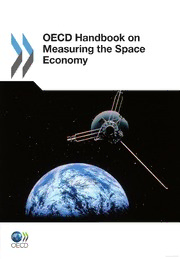
OECD handbook on measuring the space economy PDF
Preview OECD handbook on measuring the space economy
OECD Handbook on Measuring the Space Economy ©» OECD Copyrightedmaterial Copyrightedmaterial OECD Handbook on Measuring the Space Economy Q>> OECD ThisworkispublishedontheresponsibilityoftheSecretary-GeneraloftheOECD. Theopinionsexpressedandargumentsemployedhereindonotnecessarilyreflect theofficialviewsoftheOrganisationorofthegovernmentsofitsmembercountries. Thisdocumentandanymapincludedhereinarewithoutprejudicetothestatusof orsovereigntyoveranyterritory,tothedelimitationofinternationalfrontiersand boundariesandtothenameofanyterritory,cityorarea. Pleasecitethispublicationas: OECD(2012),OECDHandbookonMeasuringtheSpaceEconomy,OECDPublishing. http://dx.doi.org/10.1787/9789264169166-en ISBN978-92-64-12180-5(print) ISBN978-92-64-16916-6(PDF) Photocredits:Cover©Stocktrek/Corbis. CorrigendatoOECDpublicationsmaybefoundonlineat:www.oecd.org/publishing/corrigenda. ©OECD2012 YAptlueolbaulcrihceciaaqntnugieocsmnoatspts,ye,rfdioadartolaswpb,unablpsloreioascvdaiodnorerdcdpmortumihlmnattetirOsmcuEeiidCtaiaDlbalcueposraneotcdeakunnncttodswftolirrenadynygosouleuarmrteioonowwtnnnorfuidsgOoehcE,tuCsmaDsenhndaotsyusslo,oduuprrbcceeaesnesaniutnnbadcmtliicuootdnptesye,rdeibxglcthooetgrsrpo,[email protected].. Requestsforpermissiontophotocopyportionsofthismaterialforpublicorcommercialuseshallbeaddressed directlytotheCopyrightClearanceCenter(CCC)[email protected]’exploitationdu droitdecopie(CFC)[email protected]. . FOREWORD Foreword T heHandbooktoMeasuringtheSpaceEconomyistheresult0/collectiveefforts withintheframeworkoftheOECDInternationalFuturesProgramme(IFP),aimedat betterunderstandingthespacesectoranditswidereconomicdimensions. TheworkispartofasystematiceffortwithintheOECDtounderstandandassess thepotentialeconomic,socialandenvironmentalbenefitsofneweconomicsectors, basedontechnologicalinnovationsthatcontributetoproductivitygainsinthe economyandsocietyatlarge.Informationandcommunicationtechnologies(ICT), biotechnology-basedapplications,andspace-basedapplicationsarepartsofthisgroup ofactualorpotentialdrivers. Asthespaceeconomydevelops,policy-makers,investors,membersofthepublic andprivatesectorandacademiaincreasinglycallforaccesstocomparablestatistical datafrommajorspacefaringnationsandtheirspaceindustry.AstheHandbook suggeststhisrequiresmoretvorfeandco-operationinternationally.Althoughuseful indicatorsandstatisticsalreadyexist,anumberofmethodologicalobstaclesstill remaininordertomoreaccuratelyquantifythespacesectorandrenderdata comparableacrosscountries. Contributingtotheemergence0/economicdata,theForumonSpaceEconomics- theOECDSpaceForum-waslaunchedtoinvestigatetheeconomicdimensionsand implicationsofthespaceinfrastructureforthelargereconomy.Thisinnovative platformincludesanumber0/governmentsandspaceagenciesasfounders:ASI (AgenziaSpazialeItaliana,theItalianSpaceAgency),CNES(CentreNationald’Etudes Spatiales,theFrenchSpaceAgency),CSA(CanadianSpaceAgency),ESA(European SpaceAgency),NASA(NationalAeronauticsandSpaceAdministration),NOAA (NationalOceanicandAtmosphericAdministration),NorwegianSpaceCentre(Norsk Romsenter),theUKSpaceAgencyandUSGS(UnitedStatesGeologicalSurvey).Other actorsingovernmentalagencies,thespaceindustry,academia,industryassociations, andconsultingfirmsareregularlyinvolvedintheForumactivities.TheSpace EconomyatAGlance(2007,2011)isoneofseveraloutputsoftheForum.Itpaints adetailedpictureofthespaceindustry,itsdownstreamservicesactivities,andits widereconomicandsocialimpacts.Inparallel,casestudiesareconductedintheForum toexplorethespecificeconomicimpactsofspaceapplicationsinvarioussectors.Two publicationssummarisethe/indingssofarSpaceTechnologiesandClimate Change(2008)andSpaceTechnologiesandFoodSecurity(2012,forthcoming) OECDHANDBOOKONMEASURINGTHESPACEECONOMY©OECD2012 3 FOREWORD TheHandbooktoMeasuringtheSpaceEconomybuildsontheOECDSpace Forum'sanalyticalgroundworkandprovidesacomprehensiveapproachtomeasuring thespaceeconomy.Ittakesstocfeofcurrentissuessurroundingmeasurementsofthe spaceeconomy’scontours,identifiesthemainobstaclestobeovercome,andpresents severalauenuesforimprovementsineconomicdata.Moreworkisneededtobetter mapstatisticallythespacesectoranditsdownstreamactivities,andongoing internationalco-operationiskeytoaddressanumberofchallengesidentifiedinthis publication. ThereportwaspreparedbyClaireJolly,OECDPolicyAnalyst,underthedirection andguidanceofBarrieStevens,HeadoftheInternationalFuturesProgrammeand Pierre-AlainSchieb,HeadofFuturesProjects.AnitaGibsonprovidedadministrative andeditorialassistance.Theteamhasbenefitedfrommanycontributionssincethe beginningoftheForum,includingsuggestionsfromColinWebb,Directoratefor Science,TechnologyandIndustry(DSTI)andtheinitialsupportofPaulSchreyerand AndreasLindneroftheStatisticsDirectorate.ThanksalsogotoDirkPilatandSandrine Kergroach-ConnanofDSTIwhose2002papercommissionedbytheIFPwasthe buildingblockinthedevelopment0/thiswork.Expertsfromotherorganisationsalso contributedusefulinputs,includingA.Malfara,SeniorClassificationsSpecialistfrom StatisticsCanada.OurthanksgotomembersoftheOECDSpaceForum,who contributedexpertise,ideasanddata.Ourthanksgoalsotoexpertsinthespace communityfromindustryassociations,consultingfirmsandacademia,particularlyto PierreLionnetfromEurospace,NorihiroSakamotoformerlyfromtheSocietyof JapaneseAerospaceCompaniesandHenryHertz/eldfromtheSpacePolicyInstitute. 4 OECDHANDBOOKONMEASURINGTHESPACEECONOMY©OECD2012 TABLEOFCONTENTS TableofContents Parti BasicsonMeasuringtheSpaceEconomy Chapter1. Introduction 11 TheHandbookanditsrationale 12 WorkonspaceactivitiesatOECD 12 UsersoftheHandbook 13 Scopeandcontent 13 References IS Chapter2. DefinitionsandIndustrialClassifications 17 Definitions 18 Spaceininternationalclassifications 21 Reviewofselectednational/regionalclassifications 27 EnvisagingISICreclassificationandalternativemeasures 35 References 38 Chapter3. PrincipalActorsintheSpaceEconomy 39 Actorsbyorganisationalstructure 40 Actorsbyvaluechain 42 References 46 Chapter4. DataSourcesandGeneralMethodologicalNotes 49 Economicdatasources 50 Methodologicalnotesoneconomicdata 54 References 59 PartII OverviewofIndicatorsfortheSpaceEconomy Chapter5. ReadinessIndicators:InputstotheSpaceEconomy 63 Governmentalbudgetsforspaceactivities 64 Humanresources 68 References 71 OECDHANDBOOKONMEASURINGTHESPACEECONOMY©OECD2012 5 TABLEOFCONTENTS Chapter6. IntensityIndicators:SelectedActivitiesandOutputs intheSpaceEconomy 73 Themanufacturingspaceindustry 74 Space-basedapplicationsandderivedservices 77 Internationaltradeinselectedspaceproducts 80 Innovationforfutureeconomicgrowth:patents 81 References 86 ChaptDeerf7i.niMnegassoucriion-gecSooncoimoi-ceicmopnaocmtiscfIrmopmacstpsacferpomroSgpraacmemAecstivities.. 8909 Newcommercial/industrialactivities 92 Regional/nationaleconomicgrowth 93 Efficiency/productivitygains 95 References 97 AnnexA. UsefulManualswhenCollecting/ReportingData 99 AnnexB. Glossary 100 AnnexC. SpaceResearchandDevelopmentAppearing inDifferentFieldsofScienceandTechnology 105 Tables 2.1.Mainadvantagesandinconveniencesofusingindustrial classificationsus.specialisedindustrysurveys 24 2.2. Selectedspaceactivitiesininternationalclassifications 25 22..34.. LLiissttooffNNAAICCESCCooddeessaannddIISSIICC44eeqquuiivvaalleenncceeffoorrssppaacceeaaccttiivviittiieess..... 2382 2.5. Statisticalclassificationequivalencesforselectedspace activities:International,North-AmericanandEuropean classifications 34 2.6.ModifyingfutureISICclassifications:ProsandCons 36 2.7. ProsandConsofstartingastatisticalrapprochement withanumberofselectedcountries 37 3.1.Actorsinsatellitetelecommunications 44 3.2.Anexampleofthespacesector’svaluechainforsatellite telecommunications 45 3.3. ExamplesofusersofVSATsystems,withsystemvendors andservicesoperators(2008) 46 4.1. Industryassociationspublishingaerospacestatistics 52 4.2. Selectedsourcesofdataonthespacesector(2010-11) 54 6.1. ITUindicatorsincludingdataaboutsatelliteusage 78 6.2. DataontheVSATindustry(2010) 80 6 OECDHANDBOOKONMEASURINGTHESPACEECONOMY©OECD2012 TABLEOFCONTENTS 6.3. Patentdata’sadvantagesanddisadvantagesinreflecting inventiveactivities 85 Al.l. Usefulmanualswhencollecting/reportingdata 99 7.A3.1.Selectionofcategoriesbasedon2007revisedversion oftheFrascatiManual 106 Figures 1.1. Developmentoftheoverallspaceeconomy 15 2.1.Thespaceeconomy’ssimplifiedvaluechain 21 5.1. CivilspaceprogrammesasapercentageofcivilGBAORD forselectedcountries 65 5.2. ConservativeestimatesofspacebudgetsofG20countries,2010.... 66 5.3. SpacemanufacturingemploymentintheUK(2003-08) 69 5.4. Directemploymentinupstreamanddownstreamsegments intheUKspaceindustry 70 6.1. ConsolidatedsalesandemploymentbyEuropeanspace companies,2000-09 74 6.2. ConsolidatedsalesandemploymentbyJapanesespace manufacturingcompanies,2000-11 75 6.3. RevenuesofChinesecompaniesinvolvedinspacecraft manufacturingandnumberofemployees,1995-2009 75 6.4.Canadianspacesectorrevenuesbyactivitysectorandemployment, 1996-2008 76 6.5. RevenuesandemploymentintheUKspacesector 76 6.6.Growthincommunicationaccesspathsbytechnology,2003-05.... 79 6.7.Canadianspacesector’sexportrevenuebydestination,1996-2009.. 81 6.8. Evolutionofspace-relatedpatents,1980-2007 84 7.1. Reviewofpossibleimpactsderivedfrominvestmentsinspace programme 91 Thisbookhas... StatLinks rnn_sj AservicethatdeliversExcel®files fromtheprintedpage! TLooodkowfonrltohaedStthaetLmiantkcshaitntgheExbcoetlt®omsprriegahdts-hheaentd,cjoursntetrypoeftthheetlainbkleisntoorygoruarpIhnsteirnntehtisbrboowoske.r, scIfltiaycroktui’onrngewtriheteahdltiinhnkeg.htYothute’plP:l/D/fFidnxde.-dSobtioa.tooLkrignekdpisrteiafopinxp,.eaarnidnygoiunrmPoCreisOcEoCnnDecbtoeodkst.otheInternet,simply OECDHANDBOOKONMEASURINGTHESPACEECONOMY©OECD2012 7 Copyrightedmaterial Copyrightedmaterial
